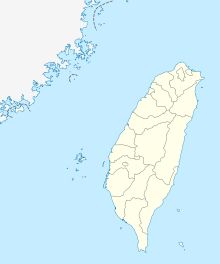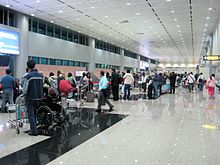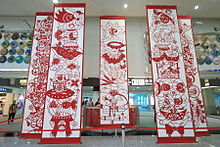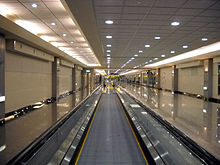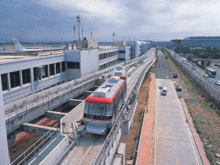- Taiwan Taoyuan International Airport
-
Taiwan Taoyuan International Airport
臺灣桃園國際機場
桃園機場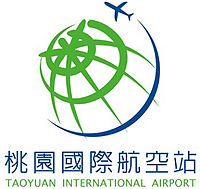
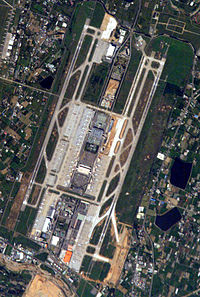
IATA: TPE – ICAO: RCTP Summary Airport type Public Owner Government of Taiwan Operator Taoyuan International Airport Corporation Serves Taipei, Taoyuan, and Hsinchu Location Taoyuan, Taiwan Hub for Elevation AMSL 107 ft / 33 m Coordinates 25°4′35″N 121°13′26″E / 25.07639°N 121.22389°ECoordinates: 25°4′35″N 121°13′26″E / 25.07639°N 121.22389°E Website Map Location in Taiwan Runways Direction Length Surface ft m 05R/23L 10,991 3,350 Paved 05L/23R 12,008 3,660 Paved Statistics (2010) Number of passengers 25,114,418 (2,010) Total cargo (metric tonnes) 1,766,883 (2,010) Aircraft movements 156,035 (2,010) Sources: Taoyuan International Airport[1][2]
Cargo data from ACI[3]Taiwan Taoyuan International Airport Traditional Chinese 臺灣桃園國際機場 Simplified Chinese 台湾桃园国际机场 Transcriptions Mandarin - Hanyu Pinyin Táiwān Táoyuán Gúojì Jīchǎng - Bopomofo ㄊㄞˊ ㄨㄢ ㄊㄠˊ ㄩㄢˊ ㄍㄨㄛˊ ㄐㄧˋ ㄐㄧ ㄔㄤˇ Min - Hokkien POJ Tâi-ôan Thô-hn̂g Kok-chè Ki-tiûⁿ Taiwan Taoyuan International Airport (IATA: TPE, ICAO: RCTP) (traditional Chinese: 臺灣桃園國際機場; simplified Chinese: 台湾桃园国际机场; pinyin: Táiwān Táoyuán Gúojì Jīchǎng), the largest airport in Taiwan, is an international airport located in Dayuan Township, Taoyuan County, Taiwan. It is one of four Taiwanese airports with regular international flights, and is by far the busiest international air entry point amongst them.[4] It is the main international hub for China Airlines and EVA Air.
The airport opened for commercial operations in 1979 and is an important regional trans-shipment center, passenger hub, and gateway for destinations in mainland China and the rest of Asia. The airport was formerly known as Chiang Kai-shek International Airport (CKS International Airport) until the name was changed in 2006 to its current name.[5]
Taiwan Taoyuan International Airport is one of two airports that serves Taipei and northern Taiwan; the other, Taipei Songshan Airport, is located within Taipei City limits and served Taipei as its international airport until 1979.[6] Now, it serves chartered flights, most of which are to and from mainland China (see Cross-strait charter), domestic flights, and some international flights.
Taiwan Taoyuan handled a total of 25,114,418 passengers in 2010.[1] It is the fifteenth-busiest air freight hub in the world[3] and thirteenth-busiest airport by international passenger traffic.
Contents
Origin of the name
The airport, originally planned as Taoyuan International Airport, bore the name of late President Chiang Kai-shek until 2006.[5] In Chinese, its former name was literally "Chung-Cheng (Zhongzheng) International Airport", where Chung-Cheng is the legal given name which Chiang Kai-shek had used since the 1910s.[7] In Taiwan, Chiang Kai-shek is associated with the Chinese Nationalist Party or Kuomintang and its many years of one-party authoritarian rule.[8] Local officials in Taoyuan County and members of the Pan-Green Coalition often referred to the hub by the name originally associated with it: "Taoyuan International Airport".[9] News organizations and local residents sometimes combined the two commonly used names as "Taoyuan Chung-Cheng Airport."[9][10]
The Executive Yuan of then-President Chen Shui-bian's administration officially approved the name Taiwan Taoyuan International Airport for the hub on September 6, 2006.[11][12][13][14] The opposition Kuomintang, which together with its political allies held a one-vote majority in the Legislative Yuan, decried the change and proposed "Taiwan Taoyuan Chiang Kai-shek International Airport" instead.[15] The disagreement, like those affecting the names of the Chiang Kai-shek Memorial Hall and other Taiwan landmarks, stands as another manifestation of the trend known as Taiwan localization among pan-Green officials and desinicization by Pan-Blue Coalition.[8] The media in mainland China has always referred to the airport as "Taoyuan International Airport" so as to avoid mentioning Chiang Kai-shek.[citation needed] Despite the name change, the airport is still known as Chiang Kai-Shek (CKS) International Airport in all official records of IATA.
History
In the 1970s, the original airport in Taipei City — Taipei Songshan Airport — had become overcrowded and could not be expanded due to space limitations. Thus, a new airport was planned to alleviate congestion.[6] The new airport opened (with Terminal 1) on February 26, 1979,[5] as part of the Ten Major Construction Projects pursued by the government in the 1970s. The airport was originally planned under the name Taoyuan International Airport but was later changed to Chiang Kai-shek International Airport in memory of former President Chiang Kai-shek.[8]
The airport is the main hub of China Airlines, the ROC's flag carrier, as well as EVA Air, a private airline established in the early 1990s. Overcrowding of the airport in recent years prompted the construction of Terminal 2, which was opened on July 29, 2000,[5] with half of its gates operational; EVA Air was the first airline to move into Terminal 2. The remaining gates opened on January 21, 2005 for China Airlines.[16] There are plans for the construction of a third terminal, which will be built to alleviate congestion in Terminals 1 and 2.
In January 2006, a Foreign Laborers' Service Center was set up[17] to provide airport pick-up services and serve the needs of migrant workers. There are service desks in the Arrival lobby of Terminal 1 and Terminal 2, and in the Departure lobby of Terminal 1. Service hotlines in Vietnamese, Thai, English, and Indonesian are provided.
Terminals
Taiwan Taoyuan International Airport currently has two terminals which are connected by two, short people movers.[18] A third terminal is planned, and a rapid transit system currently under construction will link the terminals together underground.[19]
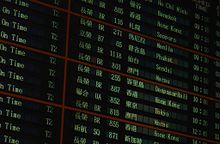 Flight information display system at Terminal 2 in Chinese and English.
Flight information display system at Terminal 2 in Chinese and English.
Terminal 1
Terminal 1 is the original passenger terminal of the Taiwan Taoyuan International Airport. The design of the building is based on the main terminal of Washington Dulles International Airport.[20] The five-story, 169,500-m2 terminal, along with the airport, opened in 1979 to relieve the overcrowded Taipei Songshan Airport.[21] All international flights were moved to the airport following the completion of this terminal. Terminal 1 featured 22 gates. A row of 11 gates are located on the north end of the airfield facing the north runway and another row of 11 gates are located on the south end airfield facing the south runway. The two concourses that contained the airplane gates are linked together by a main building that contained the check-in areas, baggage claim, passport immigration areas, and security checkpoint areas. Together they form a giant "H". All gates are equipped with jetways. Gates located at the end of the concourses have one jetway and gates not located at the end of the concourses have two jetways. The terminal used to be very white in color when it first opened. As the years gradually passed, the facade and color is becoming more tan and yellow colored due to air pollution in Taipei.
After the completion of Terminal 2, some gates from Terminal 1 were removed to make space for Terminal 2. Currently Terminal 1 has 18 gates.[22] Alphabetical letters were introduced when Terminal 2 was completed. The north concourse is now Concourse A and the south concourse is now Concourse B. Before Terminal 2, gates were numbered from 1 to 22.
Terminal 1 renovation
Terminal 1 is also currently undergoing a $57.4 million renovation that is expected to be completed by 2011.[23] The renovation includes a new facelift (designed by Japanese architect Norihiko Dan) and a new modern and stylish interior. It will also include construction of dividing walls on the east and west sides of the terminal, renovation of the arrival and departure halls, and construction of new parking garages. It will double its floor area, expand the number of check-in counters, and have enlarged shopping areas.[19] It is expected to increase Terminal 1's capacity from 12 million to 15 million passengers per year when completed.[23] The renovation will take place during late hours to avoid congestion during peak hours. It is scheduled to be completed in second quarter 2012.
Terminal 2
Terminal 2 opened in 2000 to reduce congestion in the aging Terminal 1.[24] Only the South Concourse had been completed by the time the terminal opened. The South Concourse alone has 10 gates, each with 2 jetways and their own security checkpoints. The North Concourse opened later in 2005, bringing the total number of gates for Terminal 2 to 20 gates; the security checkpoints were moved to a central location in front of the passport control. The 318,000-m2 facility is capable of handling 17 million passengers per year.[24]
The Southern and Northern Concourses are also known as Concourse C and Concourse D, respectively. Terminals 1 and 2 are connected by two short people mover lines, with one from Concourse A to D, and the other from B to C.
Airlines and destinations
Airlines Destinations Terminal Air Busan Busan 2 Air China Beijing-Capital, Chengdu, Chongqing, Hangzhou, Shanghai-Pudong, Tianjin 2 Air Macau Macau 1 AirAsia Kota Kinabalu 2 AirAsia X Kuala Lumpur 2 All Nippon Airways operated by Air Japan Tokyo-Narita 2 Asiana Airlines Seoul-Incheon 2 Cathay Pacific Fukuoka, Hong Kong, Nagoya-Centrair, Osaka-Kansai, Seoul-Incheon, Tokyo-Narita 1 Cebu Pacific Manila 1 China Airlines Amsterdam, Bangkok-Suvarnabhumi, Chiang Mai, Delhi, Denpasar/Bali, Frankfurt, Hanoi, Ho Chi Minh City, Hong Kong, Jakarta-Soekarno-Hatta, Kaohsiung, Koror, Kuala Lumpur, London-Heathrow, Manila, Penang, Phnom Penh, Phuket, Rome-Fiumicino, Seoul-Incheon, Singapore, Surabaya, Vienna, Yangon
Charter: Kuantan1 China Airlines Auckland, Beijing-Capital, Brisbane, Chengdu, Fukuoka, Guam, Guangzhou, Haikou, Hiroshima, Honolulu, Los Angeles, Miyazaki, Nagoya-Centrair, Naha, New York-JFK, Osaka-Kansai, Qingdao, San Francisco, Sanya, Sapporo-Chitose, Shanghai-Pudong, Shenzhen, Sydney, Tokyo-Narita, Vancouver, Wuhan, Xi'an 2 China Eastern Airlines Hefei, Kunming, Nanchang, Nanjing, Ningbo, Qingdao, Shanghai-Pudong, Shijiazhuang, Taiyuan, Wuhan, Wuxi, Xi'an, Yancheng 2 China Southern Airlines Changchun, Changsha, Dalian, Guangzhou, Guilin, Guiyang, Harbin, Haikou [begins 21 December], Nanning, Shanghai-Pudong, Shenyang, Shenzhen, Wuhan, Zhengzhou 2 Delta Air Lines Tokyo-Narita 2 Dragonair Hong Kong 2 EVA Air Amsterdam, Bangkok-Suvarnabhumi, Beijing-Capital, Brisbane, Chengdu, Denpasar/Bali, Fukuoka, Guam, Guangzhou, Hangzhou, Hanoi, Harbin[begins 21 December], Ho Chi Minh City, Hong Kong, Jakarta-Soekarno-Hatta, Jinan, Komatsu, Kuala Lumpur, London-Heathrow, Los Angeles, Macau, Manila, Nagoya-Centrair, New York-JFK, Osaka-Kansai, Paris-Charles de Gaulle, Phnom Penh, San Francisco, Sapporo-Chitose, Seattle/Tacoma, Sendai, Seoul-Incheon, Shanghai-Pudong, Singapore, Surabaya, Tianjin, Tokyo-Narita, Toronto-Pearson, Vancouver, Vienna, Zhengzhou 2 EVA Air
operated by Uni AirMacau 2 Fly Guam
operated by Sky King, Inc.Koror Garuda Indonesia Jakarta-Soekarno-Hatta 1 Hainan Airlines Beijing-Capital, Dalian, Guangzhou, Haikou, Lanzhou[begins December 28], Xi'an 2 Hong Kong Airlines Hong Kong 2 Japan Airlines Nagoya-Centrair, Osaka-Kansai, Tokyo-Narita 2 Jetstar Asia Airways Osaka-Kansai, Singapore 1 KLM Amsterdam, Bangkok-Suvarnabhumi 2 Korean Air Seoul-Incheon 1 Malaysia Airlines Kota Kinabalu, Kuala Lumpur, Los Angeles 1 Mandarin Airlines Kalibo 1 Mandarin Airlines Changsha, Nanjing, Ningbo, Shenyang, Xiamen, Yancheng, Zhengzhou 2 Philippine Airlines Manila 1 Shandong Airlines Jinan, Qingdao, Yantai 2 Shanghai Airlines Nanjing, Xuzhou 2 Shenzhen Airlines Shenyang, Shenzhen, Wuxi, Zhengzhou 2 Sichuan Airlines Kunming 2 Singapore Airlines Singapore 2 Spirit of Manila Airlines Clark 1 Tiger Airways Singapore 1 Thai Airways International Bangkok-Suvarnabhumi, Seoul-Incheon 1 TransAsia Airways Busan, Changsha, Chiang Mai, Macau, Singapore, Shanghai-Pudong, Phuket, Xuzhou
Charter : Hakodate, Kushiro, Koror1 TonleSap Airlines Siem Reap 2 Uni Air Chongqing, Dalian, Fuzhou, Nanjing, Ningbo, Qingdao, Shenzhen 2 United Airlines Tokyo-Narita 2 Vietnam Airlines Hanoi, Ho Chi Minh City
Charter: Da Nang
Seasonal: Can Tho1 Xiamen Airlines Changsha, Fuzhou, Hangzhou, Xiamen 2 Zest Airways Kalibo Cargo airlines
Airlines Destinations Air Hong Kong Hong Kong Air Macau Macau ANA Cargo Osaka-Kansai, Tokyo-Narita Cargolux Bangkok-Suvarnabhumi, Baku, Beirut, Budapest, Kuwait, Luxembourg Cathay Pacific Cargo Hong Kong China Airlines Cargo Abu Dhabi, Amsterdam, Anchorage, Atlanta, Bangkok-Suvarnabhumi, Chicago-O'Hare, Dallas/Fort Worth, Delhi, Frankfurt, Fuzhou, Guangzhou, Hanoi, Hong Kong, Ho Chi Minh City, Houston-Intercontinental, Jakarta-Soekarno-Hatta, Kalibo, Kaohsiung, Kuala Lumpur, Los Angeles, Luxembourg, Manchester, Manila, Miami, Milan-Malpensa, Nanjing, New York-JFK, Osaka-Kansai, Penang, Prague, San Francisco, Seattle/Tacoma, Shanghai-Pudong, Singapore, Tokyo-Narita, Xiamen DHL Aviation
operated by Air Hong KongHong Kong Emirates SkyCargo Dubai EVA Air Cargo Anchorage, Atlanta, Bangkok-Suvarnabhumi, Brussels, Chicago O'Hare, Dallas/Fort Worth, Delhi, Frankfurt, Guangzhou, Hanoi, Hong Kong, Houston-Intercontinental, Jakarta, London-Heathrow, Los Angeles, Macau, Manila, New York JFK, Osaka-Kansai, Penang, Seattle/Tacoma, Singapore, Vienna[25][26] FedEx Express Anchorage, Osaka-Kansai, Tokyo-Narita MASkargo Kuala Lumpur Nippon Cargo Airlines Tokyo-Narita Pacific East Asia Cargo Airlines Clark Singapore Airlines Cargo Singapore, Tokyo-Narita Trai Thien Air Cargo Hanoi TransGlobal Airways Clark UPS Airlines Anchorage, Clark, Cologne/Bonn, Dubai, Seoul-Incheon Operations
Operations and Statistics year Passenger
movementsAirfreight
movements
(kgs)Aircraft
movement2000 18,681,462 1,208,838,480 115,695 2001 18,460,827 1,189,873,251 123,916 2002 19,228,411 1,380,748,058 132,428 2003 15,513,885 1,500,070,877 125,692 2004 20,083,228 1,701,020,413 148,938 2005 21,700,702 1,705,317,637 152,607 2006 22,857,445 1,698,806,562 157,702 2007 23,425,794 1,605,681,101 160,120 2008 21,936,083 1,493,119,963 145,993 2009 21,616,729 1,358,303,714 139,399 2010 25,114,413 1,767,074,774 156,036 Capacity Passenger (current) 25,000,000 Passenger (ultimate) 29,000,000 Cargo (current) 1.7m tonnes The airport is operated by the Taoyuan International Airport Corporation, a company wholly owned by the Government of Taiwan. The Civil Aeronautics Administration (CAA) is responsible for the provision of air traffic control services, certification of Taiwan registered aircraft, and the regulation of general civil aviation activities.
The airport has two parallel runways, with one 3660 meters in length and another 3350 meters in length and both 60 meters wide, enabling them to cater to the next generation of aircraft. The south runway has been given a Category I Precision Approach, while the north runway has the higher Category II Precision Approach, which allows pilots to land in only 350 metre visibility. The two runways have an ultimate capacity of over 60 aircraft movements an hour. The Airport is upgrading ATC and runways.
There are 41 frontal stands at the main passenger concourse, 15 remote stands and 25 cargo stands. The airport was the seventh busiest for passenger traffic in Asia in 2010, and the world's fourteenth busiest for cargo traffic in 2008.
The operation of scheduled air services to and from Taoyuan is facilitated by air services agreements between Taiwan and other countries. Since the opening of RCTP, the Taiwan Government has implemented a policy of progressive liberalisation of air services with the intention of promoting consumer choice and competition. Many low-cost airlines have started various regional routes to compete head-on with full-service carriers on trunk routes.
The airport's long term expansion opportunities are subject to variables. An NTD 300 billion proposal to build a third runway and a third terminal has been under feasibility study and consultation. However, building a new runway would be very expensive as it would involve a huge compensation for acquiring land.
Airport Facilities
Passenger Facilities
Transportation between Terminal 1 and 2 is provided by the TTIA Skytrain, a driverless people mover system. The train transports both passengers who have cleared security and those who have not through separate train cars.
Huan Yu VIP Terminal
Huan Yu VIP Terminal, also known as the Taoyuan Business Aviation Centre (TYBAC), has began service in September 2011 and will officially open in mid-October 2011.[27] The three-story facility will have its own terminal and facilities separate from the public terminals. It will provide a multimedia conference room, passenger lounge, private rooms and showers, spa, sauna, gym, and business centre facilities.[27] Other services that will be provided include ground handling, baggage handling, fuelling, security, customs and flight planning. Passengers planning to utilize TYBAC must sign up (to the Taiwanese immigration service) 3 days before use.
Baggage and cargo facilities
The handling and transportation of mail, passenger baggage, cargo, and the operation of aerobridges and passenger stairways in Taoyuan Airport is provided by Taoyuan International Airport Services Limited (TIAS) and Evergreen Airline Services (EGAS).
TTIA currently handles over 1.5 million tonnes of cargo annually. There are two air cargo terminals in the airport: one operated by Taiwan Air Cargo Terminals Limited and the other operated by Evergreen Air Cargo Services.
Aircraft maintenance services
China Airlines Engineering and Maintenance Organization (CALEMO) and Evergreen Aviation Technologies (EGAC) both offers maintenance services at the airport. With its huge base, CALEMO, with a market share of over 75%, can offer maintenance service of 5 huge airliners, ex. Boeing 747, at a time or 3 Boeing 747s and another Airbus A330 at a time.
Ground transportation
Bus
Frequent buses link the airport to Taipei,[28] Taoyuan City,[29] Jhongli,[30] Taichung,[31] Banqiao,[32] Changhua,[33] and THSR's Taoyuan Station.[34] Bus terminals are present at both terminals.
Rail
The Taoyuan International Airport Access MRT System is scheduled to begin service in 2013 and will link both terminals to Taipei and Zhongli, Taoyuan.[35] Express services will allow for travel to Taipei Station in 35 minutes. The Taiwan High Speed Rail Taoyuan Station is about 8 km (5.0 mi) away and is accessible by shuttle bus.[34] When the Airport Access MRT System is completed, the station will also be accessible by rail.
Taxi
Taxi queues are outside the arrival halls of both terminals and are available 24 hours a day. They are metered and subject to a 15-percent surcharge.[36]
Car rental
Car rentals are available at both terminals.[37] The airport is served by National Highway No. 2.
Other facilities
CAL Park, the headquarters for China Airlines.
CAL Park
China Airlines has its headquarters, CAL Park (Chinese: 華航園區; pinyin: Huáháng Yuánqū),[38]) on the grounds of Taiwan Taoyuan International Airport. CAL Park, located at the airport entrance forms a straight line with Terminal 1, Terminal 2, and the future Terminal 3.[39]
Airport Hotels
Located adjacent the Aviation Museum and the convention center is the Novotel Taipei Taoyuan International Airport, which opened in November 2009. The 360-room hotel is equipped with restaurants, recreation and fitness centers, and a hair salon and spa.[40]
Aviation museum
The Chung Cheng Aviation Museum (Chinese: 中正航空科學館) is located on the south-eastern area of the airport between the main freeway entrance and the terminals. It was built in 1981 by Boeing under CAA contract.[41] Many retired Republic of China Air Force fighters are represented here. Its purpose is to preserve aviation history and provide public understanding of the civil aviation industry.[42]
Awards
- Airport Service Quality (Airports Council International) Best Airport in 15–25 million passengers level (2008).[43]
- Best Airport Security Processing (Skytrax World Airport Reports 2011)[44]
Future developments
In addition to the remodeling of the aging Terminal 1 (scheduled for completion by September 2011),[19] the runways and taxiways are set to be expanded by 2014 to accommodate large planes (including the Airbus A380) at a cost of NT$10.7 billion.[45] The runways will undergo their first major resurfacing and length extension in 30 years.[46] Navigation facilities will also be upgraded to reduce the effects of bad weather on airport operations. Runway and navigation aid improvement projects are expected to be completed by May 2014.[19] A high-tech US$6.4 million (NT$180 million) fence, equipped with a sensor and tracking system, will be installed around the airport by mid-2012.[47]
As part of the "Taoyuan Aerotropolis" plan (scheduled for completion in 2020), existing terminals will be expanded, a new terminal will be constructed, an aerospace industrial part will be established, and special zones for cargo, passenger and logistic services will be developed.[45] The Taoyuan Airport MRT System is scheduled to open in 2013, and will link the airport to Taipei and Taoyuan County by rail.[35]
Terminal 3
A third terminal is being planned and is expected to handle 43 million passengers per year when completed.[48] The terminal will be located west of the existing Terminal 2, with facilities for entertainment, shopping, conferences and accommodations.[49] The first stage is scheduled to be completed in 2013 or 2014,[19] while the entire project will be completed by 2018.[50] The Civil Aeronautics Administration has allocated NT$60 billion (US$1.9 billion) for construction of the new terminal.[50] Bidding is expected to open at the end of 2011.[49] A satellite terminal for check-in and additional buildings for auxiliary facilities are planned as well.[50]
Accidents and incidents
- On November 28, 1987, South African Airways Flight 295 crashed in a catastrophic fire on the Indian Ocean off Mauritius bound to Jan Smuts Airport (now OR Tambo International Airport) in Johannesburg from Chiang Kai-Shek Airport, as it was known then. All 159 passengers and crew were killed.[51]
- Taiwan Taoyuan International Airport was one of the airports targeted by the failed Project Bojinka plot in 1995.
- On February 16, 1998, China Airlines Flight 676, which was arriving from Ngurah Rai International Airport, Indonesia, crashed into a residential area while landing in poor weather, killing all 196 people on board and six on the ground.[52]
- On October 31, 2000, Singapore Airlines Flight 006, which was on a Singapore Changi Airport, Singapore-Taipei-Los Angeles International Airport, Los Angeles route rammed into construction equipment on a closed runway 05R during takeoff from Taipei. The aircraft had lifted off and crashed with 82 fatalities. At the time of the incident, the northern runways were designated 05L and 05R (parallel); the latter has since been reassigned as a taxiway.[53]
- On May 25, 2002, China Airlines Flight 611 broke up in mid-flight on the way to Hong Kong International Airport in Hong Kong from Chiang Kai-Shek Airport, as it was known then. All 225 people on board died.[54]
- On June 29, 2010, shortly after the arrival of Singapore Airlines Flight 876 from Singapore at gate D6 of Terminal 2, a jetway prepared for Business Class passengers suddenly collapsed. No passengers or staff were hurt.[55]
- On July 15, 2010, a Singapore Airlines A330 aircraft was preparing to take off when a taxiing Antonov-124 aircraft accidentally crossed its path, separated by only 1,100 meters. Investigators believe that the Antonov-124 pilots experienced a miscommunication with air traffic controllers.[56]
See also
- Taoyuan International Airport Corporation
- Taipei Songshan Airport
- Transportation in Taiwan
- Ten Major Construction Projects
External links
References
- ^ a b "Passenger Volume". Taiwan Taoyuan International Airport. http://www.taoyuan-airport.com/english/passengerqueryresult_e.jsp?cnid=1284. Retrieved 2010-06-08.
- ^ "Aircraft Volume". Taiwan Taoyuan International Airport. http://www.taoyuan-airport.com/english/flightsqueryresult_e.jsp?cnid=1280. Retrieved 2010-07-28.
- ^ a b "Year to date Cargo Traffic". Airports Council International. http://www.airports.org/cda/aci_common/display/main/aci_content07_c.jsp?zn=aci&cp=1-5-54-4819_666_2__. Retrieved 2010-06-08.
- ^ "實際入境人數-按入境地點分 Entry Persons - By Arriving Point". National Immigration Agency. http://www.immigration.gov.tw/immigration/FileSystem/Statistics/02%20%20Entry%20990430.xls. Retrieved 2010-06-09.
- ^ a b c d "`Chiang Kai-shek' airport enters dustbin of history". Taipei Times. 2006-09-07. http://www.taipeitimes.com/News/front/archives/2006/09/07/2003326501. Retrieved 2010-06-07.
- ^ a b "Taiwan News Encyclopedia: Songshan Airport". Radio Taiwan International. 2010-06-19. http://english.rti.org.tw/Content/GetSingleNews.aspx?ContentID=104139. Retrieved 2010-07-10.
- ^ "De-Chiang-ization demonizes Ma". The China Post. 2007-12-17. http://www.chinapost.com.tw/commentary/2007/12/17/135199/De-Chiang-ization-demonizes.htm. Retrieved 2010-07-10.
- ^ a b c "Taipei airport name change removes China link". iOL. 2006-09-01. http://www.iol.co.za/index.php?click_id=3&art_id=qw1157098862938B235&set_id=. Retrieved 2010-07-10.
- ^ a b "當年啟用前11天… 桃園機場硬被改名中正". Liberty Times. 2006-09-02. http://www.libertytimes.com.tw/2006/new/sep/2/today-fo1.htm. Retrieved 2010-07-10.
- ^ "濃霧影響 中正機場一度停止起降 旅客行程大亂". NOWnews. 2005-02-06. http://www.nownews.com/2005/02/06/327-1751550.htm. Retrieved 2010-07-10.
- ^ "Signboard replacement to reflect airport name-change gets underway". 2006-09-06. http://www.cna.com.tw/eng/cepread.php?id=200609060048. Retrieved 2006-09-06.[dead link]
- ^ "Cabinet approves new name for Taiwan's main international airport". 2006-09-06. http://www.iht.com/articles/ap/2006/09/06/asia/AS_GEN_Taiwan_Airport_Name.php. Retrieved 2006-09-06.
- ^ ATVnews (Hong Kong, Traditional Chinese)
- ^ BBC (Traditional Chinese)
- ^ "CKS AIRPORT SHOULD BE RENAMED 'TAIWAN TAOYUAN CKS AIRPORT': KMT". 2006-09-01. http://www.cna.com.tw/eng/cepread.php?id=200609010046. Retrieved 2006-09-03.[dead link]
- ^ China Airlines (2005-01-25). "About the D Concourse of Terminal 2". China Airlines. Archived from the original on 2006-05-10. http://web.archive.org/web/20060510111448/http://www.china-airlines.com/en/other/faq-10.htm. Retrieved 2006-05-21.
- ^ Chiang Kai-Shek International Airport (2006-01-20). "Opening of Foreign Laborer’s Service Center". Chiang Kai-Shek International Airport. http://www.cksairport.gov.tw/CKSeng/news/event_e_e.jsp?newsid=17. Retrieved 2006-05-19.
- ^ "Terminal". Taiwan Taoyuan International Airport. http://www.taoyuan-airport.com/english/Publish.jsp?cnid=702#. Retrieved 2010-06-08.
- ^ a b c d e "Major Upgrade Coming for Taoyuan Airport". CENS. 2010-06-24. http://news.cens.com/cens/html/en/news/news_inner_32713.html. Retrieved 2010-07-02.
- ^ "Why rename CKS Airport?". The China Post. 2006-09-14. http://www.chinapost.com.tw/editorial/detail.asp?onNews=&GRP=i&id=89541. Retrieved 2010-06-07.
- ^ "Termina". Taiwan Taoyuan International Airport. http://www.taoyuan-airport.com/english/Publish.jsp?cnid=702. Retrieved 2010-06-07.
- ^ "Taipei Taoyuan International Airport- Basic Information". http://www.taoyuan-airport.com/web/english/about/about_e.jsp.
- ^ a b "Taoyuan airport’s first terminal to get facelift". Taipei Times. 2009-02-24. http://www.taipeitimes.com/News/taiwan/archives/2009/02/24/2003436880. Retrieved 2010-06-07.
- ^ a b "Basic Information". Taiwan Taoyuan International Airport. http://www.taoyuan-airport.com/english/Publish.jsp?cnid=356. Retrieved 2010-06-07.
- ^ "Yahoo! News". Yahoo!. http://ph.news.yahoo.com/mb/20100326/tbs-eva-air-cargo-starts-freighter-servi-4aef023.html. Retrieved 2010-07-08.
- ^ http://www.evaair.com/html/b2c/english/eva/News/2010/EVAAri_News_Cargo_Vienna.htm
- ^ a b "Taoyuan airport readies service for business travelers". Taipei Times. 2011-08-17. http://www.taipeitimes.com/News/taiwan/archives/2011/08/17/2003510955. Retrieved 2011-08-16.
- ^ "Taipei". Taiwan Taoyuan International Airport. http://www.taoyuan-airport.com/english/Publish.jsp?cnid=100150. Retrieved 2010-06-08.
- ^ "Taoyuan". Taiwan Taoyuan International Airport. http://www.taoyuan-airport.com/english/Publish.jsp?cnid=100156. Retrieved 2010-06-08.
- ^ "Zhongli". Taiwan Taoyuan International Airport. http://www.taoyuan-airport.com/english/Publish.jsp?cnid=100158. Retrieved 2010-06-08.
- ^ "Taichung". Taiwan Taoyuan International Airport. http://www.taoyuan-airport.com/english/Publish.jsp?cnid=100152. Retrieved 2010-06-08.
- ^ "Banqiao". Taiwan Taoyuan International Airport. http://www.taoyuan-airport.com/english/Publish.jsp?cnid=100154. Retrieved 2010-06-08.
- ^ "Changhua". Taiwan Taoyuan International Airport. http://www.taoyuan-airport.com/english/Publish.jsp?cnid=100184. Retrieved 2010-06-08.
- ^ a b "High Speed Rail Shuttle". Taiwan Taoyuan International Airport. http://www.taoyuan-airport.com/english/Publish.jsp?cnid=1226. Retrieved 2010-06-08.
- ^ a b "Airport MRT travel time should be cut to 20 minutes: president". Focus Taiwan News Channel. 2010-06-06. http://focustaiwan.tw/ShowNews/WebNews_Detail.aspx?ID=201006060017&Type=aIPL. Retrieved 2010-06-08.
- ^ "Taxi". Taiwan Taoyuan International Airport. http://www.taoyuan-airport.com/english/Publish.jsp?cnid=1218. Retrieved 2011-03-16.
- ^ "Car Rentals". Taiwan Taoyuan International Airport. http://www.taoyuan-airport.com/english/Publish.jsp?cnid=1220. Retrieved 2010-06-08.
- ^ "「華航園區新建工程」1月31日隆重舉行開工動土典禮2009年底完工 將成為臺灣桃園國際機場地標." China Airlines. Retrieved on April 24, 2010. "「華航園區」預定2009年底前完工營運, ..."
- ^ "China Airlines Inaugurates CAL Park at Taoyuan Airport." China Airlines. March 26, 2010. Retrieved on March 26, 2010.
- ^ "Novotel Taipei Taoyuan International Airport". http://www.accorhotels.com/6701. Retrieved 2010-08-02.
- ^ Museum Info — Taoyuan County Government website (Chinese).
- ^ "Opening Hours". Taiwan Taoyuan International Airport. http://www.taoyuan-airport.com/english/Publish.jsp?cnid=1264. Retrieved 2010-06-08.
- ^ "ACI Airport Service Quality Awards 2008" (PDF). http://www.aci.aero/aci/aci/file/Press%20Releases/2009/PR_100309_ASQ%20Awards%20Ceremony%280%29.pdf. Retrieved 2010-07-08.
- ^ "THE 2011 WORLD AIRPORT AWARDS - full results". Skytrax. http://www.worldairportawards.com/Awards_2011/Categories.htm. Retrieved 2011-04-02.
- ^ a b "Taoyuan Airport runways to be lengthened to accommodate A380s". Focus Taiwan News Channel. 2010-03-15. http://focustaiwan.tw/ShowNews/WebNews_Detail.aspx?Type=aALL&TNo=&ID=201003150034. Retrieved 2010-03-15.
- ^ "|即時新聞|中時電子報". ChinaTimes. 1980-01-01. http://news.chinatimes.com/realtime/0,5255,110102x112010031501261,00.html. Retrieved 2010-07-08.[dead link]
- ^ "Taiwan to build high-tech airport fence". Focus Taiwan News Channel. 2011-07-24. http://focustaiwan.tw/ShowNews/WebNews_Detail.aspx?Type=aALL&ID=201107240009. Retrieved 2011-07-24.
- ^ "Plan launched to build third terminal at Taoyuan Airport". Focus Taiwan News Channel. 2010-06-07. http://focustaiwan.tw/ShowNews/WebNews_Detail.aspx?Type=aECO&ID=201006070017. Retrieved 2010-06-07.
- ^ a b "New airport terminal project to attract international bids". Taiwan News. 2011-10-03. http://www.taiwannews.com.tw/etn/news_content.php?id=1724163. Retrieved 2011-10-03.
- ^ a b c "CAA earmarking NT$60bn for new Taoyuan terminal". Taipei Times. 2010-10-20. http://www.taipeitimes.com/News/taiwan/archives/2010/10/20/2003486119. Retrieved 2011-03-22.
- ^ Battersby, John D. (1987-11-29). "160 Die at Sea in South Africa Jet Crash". The New York Times. http://www.nytimes.com/1987/11/29/world/160-die-at-sea-in-south-africa-jet-crash.html. Retrieved 2010-06-07.
- ^ Ladkin, Peter M.. The Crash of Flight CI676. 18 March 1998. The RVS Group. RVS-J-98-01. http://www.rvs.uni-bielefeld.de/publications/Reports/taipei/taipei.html. Retrieved 2007-05-30.
- ^ "Accident description". Aviation Safety Network. http://aviation-safety.net/database/record.php?id=20001031-0. Retrieved 2010-06-08.
- ^ "China Airlines Flight CI611 747-200 aircraft accident". Aviation Safety Council. http://www.asc.gov.tw/asc_en/accident_list_2.asp?accident_no=83. Retrieved 2010-06-08.
- ^ "Jetway collapses at Taoyuan airport". The China Post. 2010-06-29. http://www.chinapost.com.tw/taiwan/national/national-news/2010/06/29/262557/Jetway-collapses.htm. Retrieved 2010-07-08.
- ^ "Taipei Taoyuan reviews air control procedures after runway incident". Flightglobal. 2010-08-10. http://www.flightglobal.com/articles/2010/08/19/346331/taipei-taoyuan-reviews-air-control-procedures-after-runway.html. Retrieved 2010-08-19.
Airports in the Republic of China (Taiwan) International Cross-Strait Domestic Chiayi • Qimei • Hengchun • Lanyu • Lyudao • Matsu Beigan • Matsu Nangan • Pingtung • Tainan • Wang-anSee also: Civil Aeronautics Administration • Category:Airports in TaiwanCategories:- 1979 establishments
- Buildings and structures in Taoyuan County
- Airports in Taiwan
- Taiwan Taoyuan International Airport
Wikimedia Foundation. 2010.

